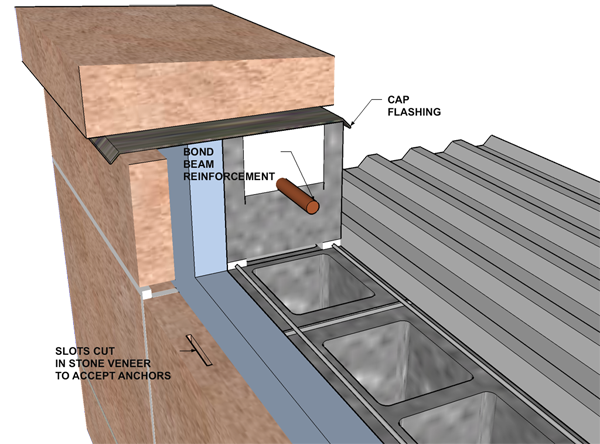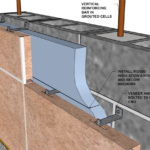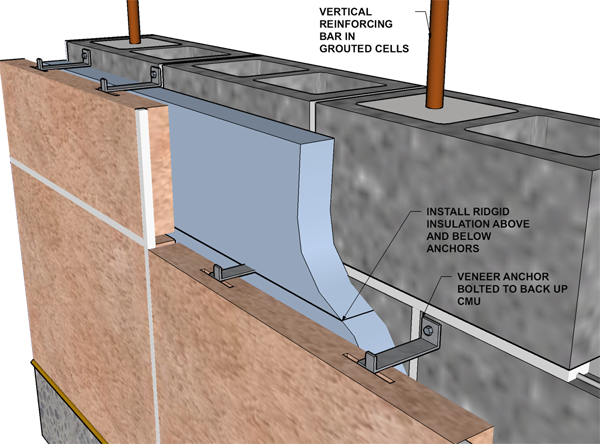Stone Slab Veneer / Reinforced Concrete Block
Beautiful stone panels over a concrete block backup system create a sophisticated and long-lasting exterior for important buildings.

Recommended Building Types
- Institutional Buildings, including museums, places of worship, universities and schools; healthcare facilities; hotels, restaurants and shopping centers; sports stadiums, theaters and casinos; and high-end single family and multi-family residential
- Buildings requiring a high fire rating
- Noisy environments
- Choosing the Right Masonry System for your Budget
Benefits
- Sophisticated, solid stone exterior over a structural concrete block backup system – works especially well in urban settings
- Nearly unlimited design potential, with many different stone types, finishes, and surface textures available
- Most types of stone have exceptional durability and are long-lasting
- Low maintenance
- concrete block backup acts as the structure, with vertical and horizontal reinforcement grouted into place
- Continuous concrete masonry backup permits anchor attachment anywhere within the field of the wall. Stud backup systems require added structural framing, placed precisely at stone anchorage points
- Excellent heat capacity
- Inherently fire proof with fire ratings up to 4 hours
- Great for noisy environments – naturally dampens sound
- One trade erects both the structural and skin layers of the wall
Special Considerations
- Lower life cycle costs offset higher initial investment
- Don’t expect a perfectly uniform appearance – stone is a natural product and there will be variations in color, veining, and surface texture
- stone can be heavier than brick or concrete block veneers – structural support and foundations may need to be larger
Definition and Assumptions
Backup: Lightweight plain gray concrete block (CMU), 8” x 8” x 16”
Reinforcement: #6 vertical reinforcement at 32” on center 9-gauge joint reinforcement at 16” o.c. (every other course)
Veneer: 2” thick limestone panels, honed finish. Face size: 24” wide, stack bond. Alternate 24” tall and 8” tall units
Cavity: 3 inch air space and 2” extruded polystyrene rigid insulation
Flashing: Base Flashing and weeps
Veneer ties: Type 304 stainless steel double-split tail anchors
Joint finish: Backer rod and sealant at all joints
Regional Variations
- When masonry veneer is used in areas of high seismic risk, Veneer ties are required to attach to wire reinforcement embedded in Mortar bed joints in the veneer. Check your local requirements – and save money by using normal Veneer ties in areas of low seismic risk.
- Many areas of the western U.S. have good local sources for lightweight aggregate, and the use of lightweight concrete block (CMU) is the norm. In other parts of the country, medium weight and normal weight block are more common.
- Structural masonry walls in areas of high seismic risk are required to have additional horizontal bond beams to resist seismic loads. Check with your structural engineer to determine what is required in your region.
- The use of reinforced bond beams can replace the necessity for joint reinforcement in concrete masonry walls. Understand that some form of horizontal reinforcement is required in all concrete masonry construction, including veneer applications.
Fire Rating (hours)
Ungrouted Assembly: 3 hrs
Fully grouted Assembly: 4 hrs
Sound Transmission class (dB)
Ungrouted: 53
Grouted 32”: 55
Fully grouted: 60
Wall Weight (lb/sq. ft.)
Ungrouted: 56 lb./sq. ft
Grouted 32”: 67 lb./sq. ft
Fully grouted: 100 lb/sq. ft
Energy Rating
R-value: 11.6 with 2” extruded polystyrene rigid insulation (See note)
Calculation:
| Outside Air | =0.17 |
| 2 inch limestone | =0.30 |
| Air Gap | =0.97 |
| 2 inch Polystyrene | =8.00 |
| 8 inch CMU 105 pcf, grouted at 32” o.c. | =1.45 |
| Interior Air | =0.68 |
| Total | =11.57 |
- R-Value/U-Factor Calculator (configurable)
- R-Values of Multi-Wythe Concrete Masonry Walls
- Introduction to Energy Performance of Brick Masonry
Note: The type of rigid insulation you install affects the wall’s insulating capacity (the R-value). Polyisocyanurate insulation gives you 8.0 R per inch (or 12.0 R for 1.5″). Extruded polystyrene insulation is worth 4.0 R per inch (6.0 R for 1.5″). Expanded polystyrene yields 5.0 R per inch (7.5 R for 1.5″). Use either thicker insulation or more expensive polyisocyanurate to achieve a higher rating
Sustainability & LEED
- Energy efficiency, thermal comfort and energy analysis – up to 10 pts
- Innovation and design – 1 pt
- Recycled content – 2 pts
- Regional material (where applicable) 2 pts
- Renewable energy and thermal mass – up to 10 pts
- Concrete Masonry and the LEED Program
- Determining the Recycled Content of Concrete Masonry Products
Design Tips
- Stone anchorage requirements are not prescribed by Building Codes. Anchor hardware needs to be engineered, and depends on the size of the panel as well as the stone type.
- Stone anchorage design is very conservative. In some cases you can reduce the number of anchors required by conducting anchor strength tests on stone samples identical to those being installed.
- Be very careful using epoxy connections where they will be subjected to sustained tension loads – many epoxies will creep and fail over time.
- Use bent anchors in field-cut kerfs or continuous slots where possible. Pin anchorage can require tight construction tolerances.
- Be careful using thin stone panels, which are prone to breakage and will require more anchors than a thicker panel. Some stones (such as marble) will warp over time if the panels are thin.
- Mortar is acceptable for small-size stone panels. Use a more flexible Type N Mortar to minimize the potential for joint cracking.
- Use backer rod and flexible sealant in all joints whenever the panel size exceeds 2 feet.
- Sealants can bleed into surrounding stone – check with the stone supplier and sealant manufacturer for recommended sealant types and advice on preparing joint surfaces to receive sealant.
- Use stainless steel hardware for attaching stone panels to the backup structure to minimize corrosion and stone staining.
- Isolate dissimilar metals (such as stainless steel and bare steel) with plastic washers or other similar materials to prevent galvanic corrosion.
Construction Tips
- Fill anchor slots in stone slabs with flexible caulk after placement to prevent water fro collecting and cracking the stone.
- Don’t fill anchor slots with gypsum cement (plaster of Paris), which can expand and crack the anchor slot.
- Hidden lintels installed in kerfs cut into the back of the stone lead to stress concentrations and cracks telegraphing through to the wall face.








